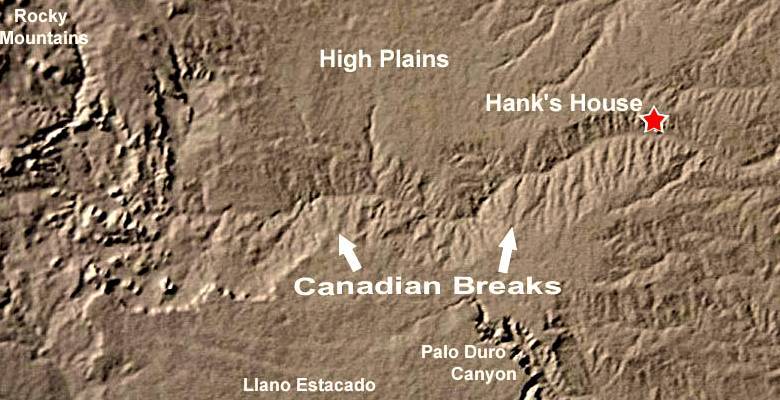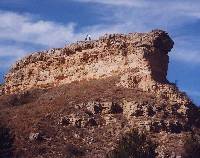
Caprock not too far from Hank's house.
The caprock is a thick layer of hard caliche at the top of
the Ogallala geological formation. Look carefully and you
will see two men standing atop the caprock. Photo by Kris
Erickson.
|
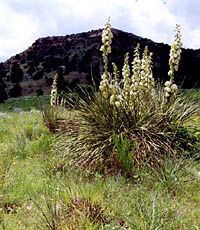
The Canadian River valley was a rich environment
for prehistoric peoples. Many plants and animals were available
at different seasons of the year for people to hunt and gather.
A single resource, such as these yucca plants growing near
the Canadian river, could provide lots of food and many other
useful materials. Even the roots of the yucca may be dug up,
cooked, and eaten or made into soap. The long leaves can be
woven into baskets or sandals or stripped down to remove fibers
that can then be made into cords and ropes. Photo by Kris
Erickson.
|
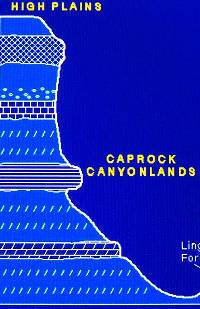
Idealized geological section of the Texas
Panhandle. Click to see formation names.
|
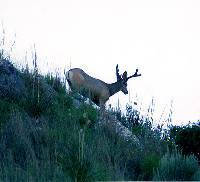
Buck picks his way down the steep terrain
of the Canadian Breaks. Photo by Kris Erickson.
|
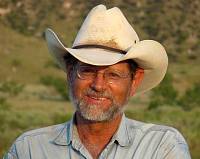
John Erickson. Photo by Bill Pierson..
|

Doug Boyd.
|
|
The M-Cross Ranch is located about 25 miles southeast
of Perryton, Texas, and just north of the Canadian River valley.
The northern portion of the ranch is on the flat, treeless expanse
of grassland known as the High Plains, but most of the ranch extends
down into the Canadian Breaks, a rugged landscape formed
by erosion. Over many hundreds of thousands of years, as the Canadian
River gradually cut its way through the layers of earth and rock,
it washed away untold billions of tons of sediment. The process
exposed the Ogallala formation and created numerous steep-walled
canyons. The Ogallala formation consists of various layers of gravels
and sands but is capped by a thick layer of hard caliche that forms
the caprock edge of the High Plains. Because this caliche
layer is more resistant to erosion than the underlying layers, it
also forms the rim of the canyons in the Canadian Breaks.
The geology of the area helps explain the natural
resources there. The Ogallala formation is buried under most
of the High Plains, from Texas up into Canada, and it is one of
the most important freshwater aquifers in the United States. An
aquifer is simply an underground pool of water trapped in the sediment.
As rainwater soaks down through the soil and through cracks in the
rocks, it begins to collect within certain layers deep underground.
These aquifer layers may contain billions of gallons of water. In
the twentieth century, technology allowed humans to pump water from
the Ogallala aquifer all across the High Plains, first with
windmills and later with modern gas or electric-powered pumps. Prehistoric
people couldn't dig deep wells to pump the water, but they didn't
have to because the water flows out naturally in many places, called
springs. Freshwater springs occur in deep canyons where erosion
has exposed much of the Ogalalla formation and the waters trapped
in the aquifer simply flow out of the porous lower layers.
The Texas Panhandle climate is called "semi-arid,"
meaning that it is pretty darn dry. The average precipitation on
the High Plains is about 18 inches a year, but the distribution
of rainfall is quite variable and unpredictable in any given year
and between years. Drought conditions—periods when the amount
of rainfall is much less than average —are common and may last
for a few months or several years. Water is a very important resource
for people who live there today, and this was true throughout prehistory.
Because of the many springs emerging in the canyons of the Canadian
River Breaks, this region was literally an oasis in an otherwise
near-desert environment. The springs and spring-fed creeks provided
abundant water in the canyons, and the water supported a wide range
of plant life. The abundant water and plant life, in turn, attracted
a diverse range of animals. Locations where abundant water, plants,
and animals were present have always attracted people, and the Canadian
River Breaks were no exception. Archeologists have found good evidence
that people have been visiting the breaks for at least 13,500 years.
The list of plants and animals available to prehistoric
peoples in the Canadian River Breaks is too long to present here,
but several important sources of food warrant mention. Certainly
people hunted, killed, and ate many types of birds, reptiles, fish,
mussels, amphibians, and small mammals (such as rabbits, rodents,
and prairie dogs), but the three largest mammals—buffalo, deer,
and antelope—were the most important sources of meat and also
of hides. The buffalo was especially important because one animal
could provide many hundreds of pounds of meat. The list of wild
plant foods that were probably used is even more extensive. Some
of the more important plant foods were mesquite beans, fruits and
pads of prickly pear and other cacti, leaves and seeds of various
grasses and forbs (such as sunflower, chenopodium, and amaranth),
grapes and plums, yucca roots and flower petals, shin oak acorns,
and hackberry seeds. Relatively speaking, the Canadian River Breaks
was rich in resources. The late Jack T. Hughes (former professor
of anthropology at West Texas State University) used to say that
the canyonlands of the Texas Panhandle were a grocery store of resources
if you knew how to shop there.
Hank's site is located about five miles north of the
Canadian River, tucked away in a beautiful canyon near the head
of a spring-fed tributary. John Erickson calls this canyon the "West
Pasture," and the main spring along this canyon is called Indian
Springs. This spring still flows today, but it is only a trickle
compared to what it would have been in prehistoric times long before
modern gas-powered engines were used to pump water out of the Ogallala
aquifer in the twentieth century. Prehistoric people were drawn
to the West Pasture valley because of the abundant fresh water and
the plants and animals available there.
Several archeologists have been working with John
Erickson to learn more about the archeological sites on
the M-Cross ranch. Doug Wilkens, a resident of Perryton,
Texas and a Panhandle regional steward with the Texas Historical
Commission's Texas Archeological Stewardship Network (TASN), began
doing archeological studies on the ranch in the early 1990s. The
TASN is a network of dedicated volunteer archeologists who work
with people in their own area to promote protection, preservation,
and documentation of archeological sites and information. Wilkens
is extremely knowledgeable in the archeology of his region and an
important advocate for why scientific archeology is far more meaningful
than simply collecting artifacts. Over a period of several years,
Wilkens and Erickson surveyed many parts of the ranch, recorded
dozens of sites including many large and important village sites
in the West Pasture, and conducted test excavations at some of the
sites. Wilkens and Erickson also enticed two other individuals to
become involved with the archeological research on the M-Cross.
One is Brett Cruse, an archeologist with the Texas Historical
Commission who directs the TASN program for the Texas Panhandle
region. The other is me, Doug Boyd, a vice president with
a cultural resources contracting firm in Austin, Texas. The one
thing that the four of us have in common is we all were born and
raised in the Texas Panhandle and have a deep appreciation for all
the people who lived there before us.

|
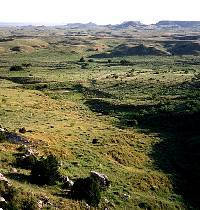
The Canadian Breaks near Hank's house in
spring-green grass. Photo by Kris Erickson.
Click images to enlarge
|
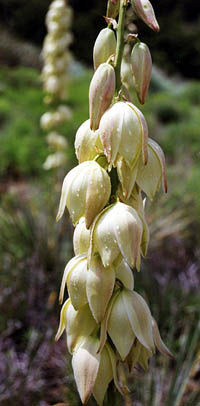
The flower petals and stalks of the yucca
can be eaten in the springtime. Photo by Kris Erickson.
|
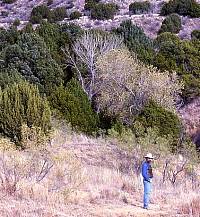
Archeologist Doug Wilkens stands below
Indian Springs on the M-Cross Ranch. The relatively lush vegetation
gives away the springs location today, just as it must have
in times past. As you might expect from the name and from
the presence of a water source, there is an archeological
site nearby. Photo by Doug Boyd.
|
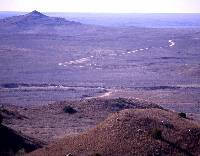
View south across the West Pasture of the
M-Cross Ranch. Hank's house was found in the cutback of the
arroyo in the foreground. Photo by Doug Boyd.
|
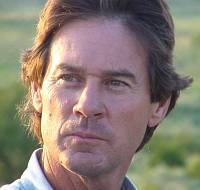
Doug Wilkens. Photo by Bill Pierson.
|
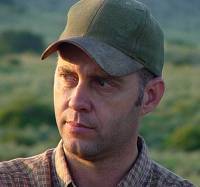
Brett Cruse. Photo by Bill Pierson.
|
|
